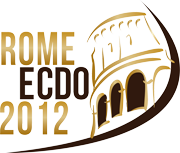
9th Training course on 'Concepts and Methods in Programmed Cell Death'
September 14-17, 2012
Rome, Italy
Program
General information

Day 1

Day 2

Day 3

Day 4

Downloads

Registration
Abstracts
Venue
Scholarships
Sponsors
Practical information
Contacts

Monday September 17, 2012
Joint sessions with "9th International Meeting on Yeast Apoptosis" |
| 08:30-09:15 | Guido Kroemer (Paris, France): Sponsored by EMBO |
| Autophagy regulation at the level of the acetylproteome | |
| 09:15-09:30 | Giuseppe Filomeni (Rome, Italy) |
| Age-dependent modulation of GSNO reductase by cytosine methylation and its impact on mitochondrial dynamics and mitophagy: A new pathway through which metabolism and epigenetics affect redox signaling | |
| 09:30-09:45 | Vladimir I. Titorenko (Montreal, Canada) |
| Mitophagy is a longevity assurance process that in yeast sustains functional mitochondria, maintains lipid homeostasis, and protects cells from apoptotic and “lipoptotic” modes of cell death | |
| 09:45-10:00 | Jason Sims (Trieste, Italy) |
| Chromosome Translocation Affects the Life Span of Saccharomyces cerevisiae | |
| 10:00-10:30 | Valter Longo (Los Angeles, USA) |
| Acetic acid is a non-toxic ketone body-like carbon source metabolized by tor/sch9 deficient mutants to extend longevity in S. cerevisiae | |
| 10:30-11:00 | Frank Madeo (Graz, Austria) |
| Spermidine: A novel autophagy inducer and longevity elixir | |
| 11:00-11:30 | Coffee |
| 11:30-12:00 | Kodi S. Ravichandran (Charlottesville, Virginia, USA) |
| Apoptotic cell clearance by bronchial epithelial cells critically influences airway inflammation | |
| 12:00-12:15 | Gudrun Strauss (Ulm, Germany) |
| Recombinant CD95-Fc (APG101) prevents graft-versus-host disease in mice without disabling anti-tumor cytotoxicity and T cell functions | |
| 12:15-12:30 | Walter Malorni (Rome, Italy) |
| Mitochondrial raft-like microdomains in cell death process: another brick in the wall | |
| 12:30-13:00 | Laurence Zitvogel (Paris, France) |
| The IFN/IFNRA pathway in the response to immunogenic cell death |
Concluding remarks |